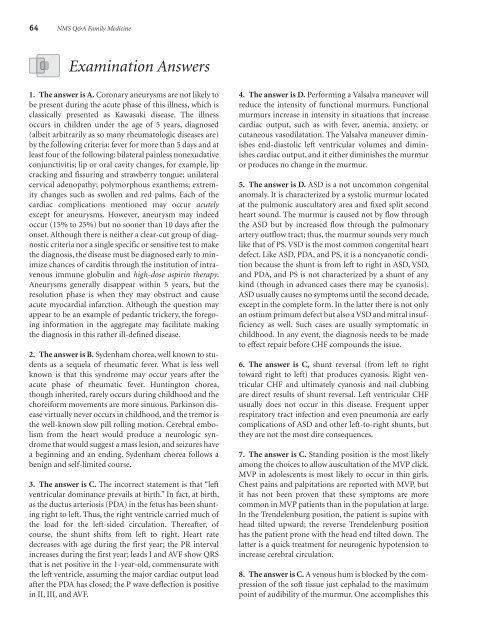NMS Q&A Family Medicine
NMS Q&A Family Medicine
NMS Q&A Family Medicine
- No tags were found...
You also want an ePaper? Increase the reach of your titles
YUMPU automatically turns print PDFs into web optimized ePapers that Google loves.
64 <strong>NMS</strong> Q&A <strong>Family</strong> <strong>Medicine</strong>Examination Answers1. The answer is A. Coronary aneurysms are not likely tobe present during the acute phase of this illness, which isclassically presented as Kawasaki disease. The illnessoccurs in children under the age of 5 years, diagnosed(albeit arbitrarily as so many rheumatologic diseases are)by the following criteria: fever for more than 5 days and atleast four of the following: bilateral painless nonexudativeconjunctivitis; lip or oral cavity changes, for example, lipcracking and fissuring and strawberry tongue; unilateralcervical adenopathy; polymorphous exanthems; extremitychanges such as swollen and red palms. Each of thecardiac complications mentioned may occur acutelyexcept for aneurysms. However, aneurysm may indeedoccur (15% to 25%) but no sooner than 10 days after theonset. Although there is neither a clear-cut group of diagnosticcriteria nor a single specific or sensitive test to makethe diagnosis, the disease must be diagnosed early to minimizechances of carditis through the institution of intravenousimmune globulin and high-dose aspirin therapy .Aneurysms generally disappear within 5 years, but theresolution phase is when they may obstruct and causeacute myocardial infarction. Although the question mayappear to be an example of pedantic trickery, the foregoinginformation in the aggregate may facilitate makingthe diagnosis in this rather ill-defined disease.2. The answer is B. Sydenham chorea, well known to studentsas a sequela of rheumatic fever. What is less wellknown is that this syndrome may occur years after theacute phase of rheumatic fever. Huntington chorea,though inherited, rarely occurs during childhood and thechoreiform movements are more sinuous. Parkinson diseasevirtually never occurs in childhood, and the tremor isthe well-known slow pill rolling motion. Cerebral embolismfrom the heart would produce a neurologic syndromethat would suggest a mass lesion, and seizures havea beginning and an ending. Sydenham chorea follows abenign and self-limited course.3. The answer is C. The incorrect statement is that “leftventricular dominance prevails at birth.” In fact, at birth,as the ductus arteriosis (PDA) in the fetus has been shuntingright to left. Thus, the right ventricle carried much ofthe load for the left-sided circulation. Thereafter, ofcourse, the shunt shifts from left to right. Heart ratedecreases with age during the first year; the PR intervalincreases during the first year; leads I and AVF show QRSthat is net positive in the 1-year-old, commensurate withthe left ventricle, assuming the major cardiac output loadafter the PDA has closed; the P wave deflection is positivein II, III, and AVF.4. The answer is D. Performing a Valsalva maneuver willreduce the intensity of functional murmurs. Functionalmurmurs increase in intensity in situations that increasecardiac output, such as with fever, anemia, anxiety, orcutaneous vasodilatation. The Valsalva maneuver diminishesend-diastolic left ventricular volumes and diminishescardiac output, and it either diminishes the murmuror produces no change in the murmur.5. The answer is D. ASD is a not uncommon congenitalanomaly. It is characterized by a systolic murmur locatedat the pulmonic auscultatory area and fixed split secondheart sound. The murmur is caused not by flow throughthe ASD but by increased flow through the pulmonaryartery outflow tract; thus, the murmur sounds very muchlike that of PS. VSD is the most common congenital heartdefect. Like ASD, PDA, and PS, it is a noncyanotic conditionbecause the shunt is from left to right in ASD, VSD,and PDA, and PS is not characterized by a shunt of anykind (though in advanced cases there may be cyanosis).ASD usually causes no symptoms until the second decade,except in the complete form. In the latter there is not onlyan ostium primum defect but also a VSD and mitral insufficiencyas well. Such cases are usually symptomatic inchildhood. In any event, the diagnosis needs to be madeto effect repair before CHF compounds the issue.6. The answer is C, shunt reversal (from left to righttoward right to left) that produces cyanosis. Right ventricularCHF and ultimately cyanosis and nail clubbingare direct results of shunt reversal. Left ventricular CHFusually does not occur in this disease. Frequent upperrespiratory tract infection and even pneumonia are earlycomplications of ASD and other left-to-right shunts, butthey are not the most dire consequences.7. The answer is C. Standing position is the most likelyamong the choices to allow auscultation of the MVP click.MVP in adolescents is most likely to occur in thin girls.Chest pains and palpitations are reported with MVP, butit has not been proven that these symptoms are morecommon in MVP patients than in the population at large.In the Trendelenburg position, the patient is supine withhead tilted upward; the reverse Trendelenburg positionhas the patient prone with the head end tilted down. Thelatter is a quick treatment for neurogenic hypotension toincrease cerebral circulation.8. The answer is C. A venous hum is blocked by the compressionof the soft tissue just cephalad to the maximumpoint of audibility of the murmur. One accomplishes this
















